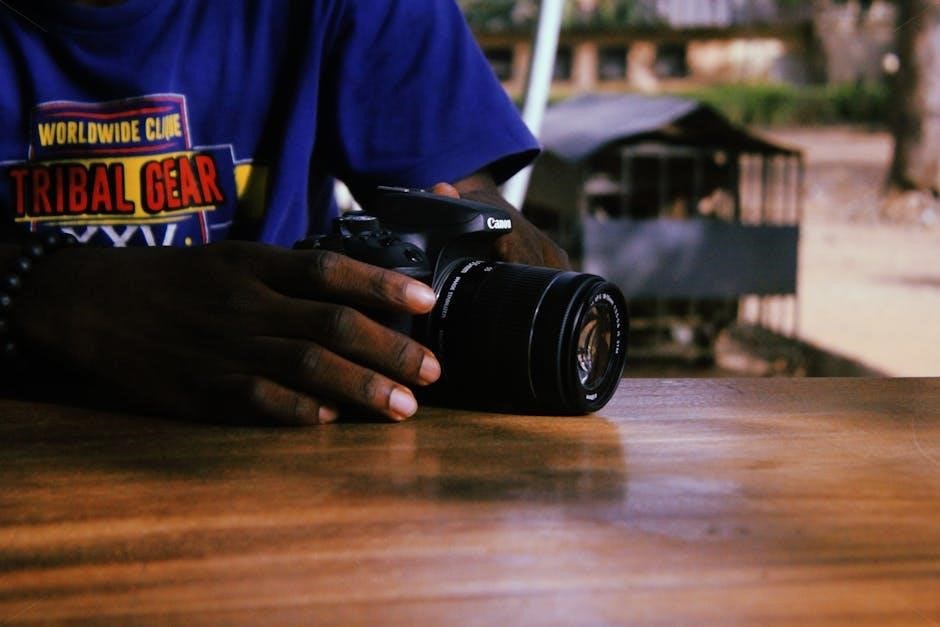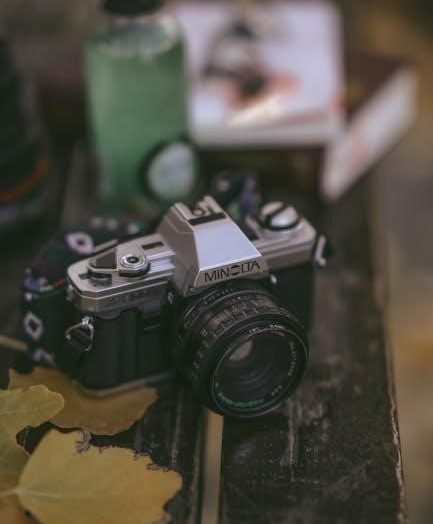The Canon EOS 70D is a high-performance DSLR designed for aspiring photographers and videographers, featuring a 20.2MP sensor, Dual Pixel CMOS AF, and vari-angle touchscreen LCD. Its comprehensive manual ensures mastering all advanced features.
Overview of the Canon EOS 70D Camera
The Canon EOS 70D is a versatile DSLR camera designed for both photography and videography enthusiasts. It features a 20.2-megapixel APS-C CMOS sensor, Dual Pixel CMOS AF for enhanced autofocus, and a vari-angle 3-inch touchscreen LCD. The camera supports Full HD video recording at 1080p and offers built-in WiFi for seamless image sharing. With ISO sensitivity up to 12800, it performs well in low-light conditions. The EOS 70D is compatible with Canon’s extensive range of EF and EF-S lenses, making it a flexible choice for various shooting scenarios. Its robust build and intuitive controls cater to both beginners and advanced users, while the comprehensive instruction manual ensures easy navigation of its advanced features.
Key Features of the Canon EOS 70D
The Canon EOS 70D boasts a 20.2-megapixel APS-C CMOS sensor, delivering crisp images and excellent low-light performance. It features Dual Pixel CMOS AF, enabling fast and precise autofocus during live view and video recording. The camera includes a vari-angle 3-inch touchscreen LCD, allowing for intuitive composition and playback. With built-in WiFi, users can transfer images wirelessly and control the camera remotely. The EOS 70D supports full HD video recording at 1080p and offers manual controls for enhanced creativity. Its robust design and weather-sealing ensure durability, while the 19-point all-cross-type AF system provides reliable subject tracking. These features make the 70D a versatile tool for both still photography and videography.

Camera Layout and Controls
The Canon EOS 70D features an intuitive design with a mode dial, navigation buttons, and a Vari-angle touchscreen LCD. Controls are strategically placed for easy access during shooting.
Understanding the Mode Dial and Shooting Modes
The Canon EOS 70D features a mode dial that offers various shooting options to suit different photography needs. The dial includes Manual (M), Aperture Priority (Av), Shutter Priority (Tv), and Program (P) modes, allowing users to control exposure settings. Additionally, it provides Scene modes such as Portrait, Landscape, Close-up, Sports, and Night Portrait for optimized results in specific conditions. The Creative Auto mode simplifies adjustments for beginners, while the Auto mode handles all settings automatically. Custom modes (C1-C3) enable users to save personalized configurations for quick access. Each mode is designed to cater to different skill levels, ensuring flexibility and creativity in capturing images effectively.
Navigation and Button Functions
The Canon EOS 70D features an intuitive control layout designed for easy navigation. The mode dial on the top provides quick access to shooting modes, while the multi-controller on the rear allows for precise AF point selection. The quick control button enables rapid access to frequently used settings, and the touchscreen LCD simplifies menu navigation. Dedicated buttons for ISO, AF, and drive modes are strategically placed for efficient operation. The rear dial and front dial adjust aperture and shutter speed, respectively, in manual modes. The camera’s ergonomic design ensures that all controls are within easy reach, making it user-friendly for photographers of all skill levels. Mastering these buttons and functions is essential for unlocking the camera’s full potential.

Shooting Modes and Settings
The Canon EOS 70D offers versatile shooting modes, including Manual (M), Aperture Priority (Av), Shutter Priority (Tv), and Program (P), allowing precise control over ISO, aperture, and shutter speed for optimal results.
Manual Mode (M)
Manual Mode (M) on the Canon EOS 70D offers full creative control, allowing users to independently adjust aperture, shutter speed, and ISO settings. This mode is ideal for experienced photographers who want precise control over exposure and artistic expression. By rotating the Main Dial and Quick Control Dial, you can set aperture and shutter speed respectively, while ISO can be adjusted using the dedicated ISO button. Dual Pixel CMOS AF ensures smooth and accurate autofocus during manual shooting. The vari-angle touchscreen LCD provides a clear preview of settings and composition. Manual Mode is perfect for capturing unique effects, such as motion blur or shallow depth of field, giving photographers the freedom to experiment and achieve their creative vision.
Aperture Priority Mode (Av)
In Aperture Priority Mode (Av), you control the aperture, while the camera automatically adjusts the shutter speed to ensure proper exposure. This mode is ideal for photographers who want to creatively manage depth of field without worrying about shutter speed. A smaller aperture (higher f-stop value) sharpens more of the image, while a larger aperture (lower f-stop value) blurs the background. The EOS 70D’s 20.2MP sensor and advanced autofocus system enhance image quality in this mode. Use the aperture wheel to adjust settings, and the camera will adapt to maintain the correct exposure. This mode is particularly useful for portraits, landscapes, and macro photography, where depth of field control is critical.
Shutter Priority Mode (Tv)
In Shutter Priority Mode (Tv), you control the shutter speed while the camera automatically adjusts the aperture to ensure proper exposure. This mode is ideal for capturing motion effects, such as freezing fast-moving subjects or creating artistic blur. To use Tv mode, turn the Mode Dial to “Tv” and adjust the shutter speed using the Main Dial. The camera will automatically set the aperture based on the lighting conditions. You can also adjust ISO settings manually or let the camera handle it automatically for better flexibility. Use this mode to experiment with creative effects, such as panning shots or low-light photography. The exposure level indicator on the LCD will help you achieve the perfect balance for your shots.
Program Mode (P)
Program Mode (P) on the Canon EOS 70D offers a balance between automation and creative control. The camera automatically sets both aperture and shutter speed but allows adjustments to ISO, white balance, and other settings. This mode is ideal for everyday shooting, as it adapts to various lighting conditions while enabling customization. Users can tweak exposure compensation for brighter or darker results. Metering modes like Evaluative, Center-Weighted, and Spot can also be selected. While the camera handles most settings, Program Mode provides flexibility for those who want to experiment without manual control. It’s a great starting point for transitioning from auto to advanced modes.

Autofocus and Metering
The Canon EOS 70D features advanced autofocus with Dual Pixel CMOS AF, enabling precise subject tracking. Metering modes include Evaluative, Center-weighted, and Spot for accurate exposure control in various lighting conditions.
Understanding Autofocus Modes
The Canon EOS 70D offers advanced autofocus capabilities, enhanced by its Dual Pixel CMOS AF technology. The camera features multiple autofocus modes, including One-Shot AF, AI Servo AF, and Manual Focus. One-Shot AF is ideal for stationary subjects, locking focus instantly. AI Servo AF is designed for moving subjects, continuously adjusting focus to track motion. Manual Focus allows precise control for creative purposes. The Dual Pixel technology enables smooth and fast autofocus during live view and video recording. Users can select AF points manually or let the camera automatically detect and track subjects. Customizable AF settings, such as AF point selection and tracking sensitivity, provide flexibility for various shooting scenarios. This system ensures sharp images and videos, even in challenging conditions.
Configuring Metering Modes
The Canon EOS 70D offers four metering modes to ensure accurate exposure: Evaluative, Center-Weighted, Partial, and Spot. Evaluative metering analyzes the entire scene, while Center-Weighted prioritizes the central area. Partial metering focuses on a smaller central zone, ideal for backlit subjects. Spot metering measures light from a precise location, useful for high-contrast scenes. To configure metering modes, press the Metering Mode button (near the LCD) and rotate the Main Dial. Use the Quick Control Dial to select your preferred mode. The selected mode appears on the LCD and in the viewfinder. Experiment with these modes to achieve optimal exposure in various lighting conditions.

Live View and Video Shooting
The Canon EOS 70D offers advanced Live View and video capabilities, featuring a vari-angle touchscreen LCD and Dual Pixel CMOS AF for precise autofocus. It records Full HD video with manual controls for focus and exposure, enhancing creative flexibility.
Enabling and Using Live View
To enable Live View on the Canon EOS 70D, press the Set button located at the center of the Quick Control Dial. Use the dial to navigate to the Live View Shooting option in the menu and select it. Once activated, the rear LCD screen will display a real-time preview of your scene, allowing precise focus control and composition. The vari-angle touchscreen LCD is particularly useful for capturing shots from unique angles. To focus, tap the area on the screen or use the AF button. After capturing an image, review it using the Playback button. Live View is ideal for video recording and ensures accurate framing. Remember to toggle between the LCD and optical viewfinder as needed for convenience. This feature enhances creativity and precision in your photography. Always refer to the manual for detailed settings customization.
Recording Video with the Canon EOS 70D
The Canon EOS 70D excels in video recording, offering Full HD (1080p) resolution at frame rates of 24, 25, and 30 fps. It also supports 720p at 60 fps for smooth motion. The Dual Pixel CMOS AF enables fast and precise autofocus during video, making it ideal for dynamic scenes. Users can manually adjust settings like aperture, shutter speed, and ISO for creative control. The vari-angle touchscreen LCD simplifies framing and focusing, especially for vlogging or unusual angles. Built-in stereo microphones capture quality audio, while the HDMI port allows for uncompressed video output. The camera also supports time-lapse and HDR movies, enhancing its versatility for multimedia projects. Its intuitive interface ensures seamless switching between stills and video modes, making it a powerful tool for content creators.
Wireless Connectivity and Sharing
The Canon EOS 70D supports WiFi connectivity for seamless image transfer to devices. Use an 8-digit PIN for secure connections, enabling easy sharing and remote camera control.
Setting Up WiFi on the Canon EOS 70D
To set up WiFi on the Canon EOS 70D, access the camera’s menu and navigate to the Wireless Communication settings. Select Connect to Smartphone or Connect to Computer based on your preference. Enter the 8-digit PIN displayed on the camera’s LCD into the device you’re connecting to. Ensure both devices are on the same network. For a direct connection, enable the camera’s WiFi function and follow the on-screen instructions. Refer to the instruction manual for detailed steps and troubleshooting tips to establish a secure and stable connection.
Transferring Images Wirelessly
The Canon EOS 70D supports wireless image transfer, enabling users to share photos effortlessly. To set up WiFi, select the camera’s access point mode and enter the 8-digit PIN displayed on the LCD. Once connected, images can be transferred to compatible devices or computers using Canon’s software solutions. This feature is ideal for backing up photos or sharing them instantly. The WiFi function streamlines workflows, making it convenient for photographers to manage their content wirelessly. Ensure the camera and receiving device are on the same network for a seamless transfer experience. This capability enhances productivity and accessibility, making the EOS 70D a versatile tool for modern photography needs.
Maintenance and Troubleshooting
Regularly clean the camera’s exterior with a soft cloth and sensor with swabs. Refer to the manual for solutions to common issues like error codes or connectivity problems.
Cleaning the Camera and Sensors
Regular cleaning of the Canon EOS 70D ensures optimal performance and image quality. Use a soft, dry cloth to wipe the camera body and lens surfaces. For the image sensor, enable the Mirror Lockup feature to access it. Gently blow air using a hand blower or Canon’s EOS Cleaning Kit to remove dust. Avoid touching the sensor with your fingers or using harsh chemicals. For stubborn spots, lightly brush with a specialized sensor-cleaning brush. Never use compressed air directly on the sensor; Clean the LCD screen with a microfiber cloth and avoid applying pressure. Always store the camera in a protective case to prevent dust accumulation. Refer to the manual for detailed cleaning procedures to maintain your equipment in pristine condition.
Common Issues and Solutions
Users of the Canon EOS 70D may encounter issues such as autofocus inconsistencies, slow buffer clearance, or Wi-Fi connectivity problems. For autofocus issues, ensure the lens is clean and firmware is updated. If the buffer is slow, using faster memory cards can resolve the problem. Wi-Fi issues often require resetting the camera’s network settings or updating the firmware. Additionally, some users report battery drain, which can be mitigated by disabling unnecessary features like GPS. Regularly cleaning the sensor and updating software helps maintain optimal performance. These solutions, detailed in the manual, ensure a smoother shooting experience.
